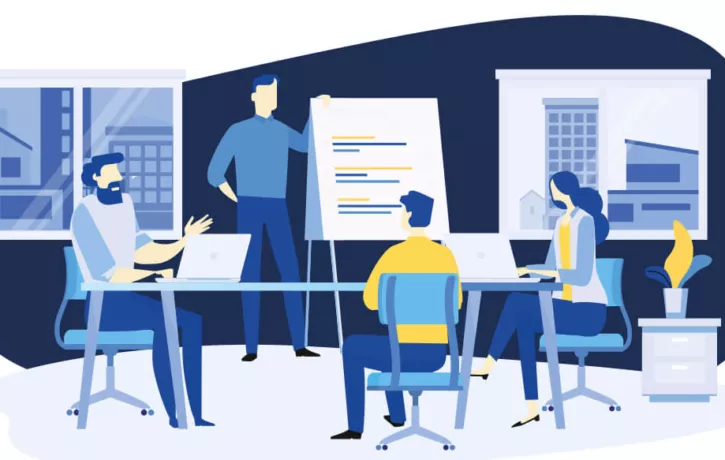As the modern workplace evolves, the role of HR is rapidly expanding. Here’s what you need to know.
Traditionally, human resources is defined as the staff, tools, and services required to help manage all personnel within an organization. But the nature of work — from physical office spaces to digital tools to organizational hierarchies — is evolving at a rapid pace.
It’s time for a new human resources definition.
In 2021 and beyond, HR must become more than a department. The definition of HR must transcend the core functions that will always remain essential, and expand to include a number of growing priorities.
Human resources should become a mechanism for improving the overall lifestyle of employees. This includes offering a more expansive range of employee benefits, protecting the employee digital experience, and providing ongoing support to ensure employee well-being.
Breaking down the new human resources definition
Certain core HR responsibilities will always remain essential, like managing the recruitment processes, onboarding, and compensation.
However, there are fundamental changes taking place to the way we work and these will affect how HR interacts with the rest of the organization.
To stay up-to-date with these challenges, we broke down the new human resources definition into five key components.
1. Protecting the digital employee experience
 Initiatives to bolster your organizations’ technological capabilities are supposed to create great value. Digital tools have the potential to improve operational efficiency, increase collaboration, open new revenue streams, and more.
Initiatives to bolster your organizations’ technological capabilities are supposed to create great value. Digital tools have the potential to improve operational efficiency, increase collaboration, open new revenue streams, and more.
However, the influx of new digital tools takes a toll on your workforce. If the digital employee experience is bad, the overall experience will suffer.
Employees may be dealing with tens of different digital platforms and apps in a single day. For those that live in the cloud, routine updates require constant relearning and support.
HR must be aware of how the usability and efficiency of digital tools impact the digital employee experience and the general employee experience at large.
Part of the new human resources definition includes providing ample software onboarding and digital support tools. By taking measures to protect the digital employee experience, you can prepare your workforce to succeed while making their work lives easier.
Dive Deeper: Do Humans Still Have a Place in Human Resource Management?
2. Embracing AI
Artificial Intelligence is poised to make a major impact on the modern workplace.
Some fear the introduction of AI means being taken over by robots or administrative jobs becoming obsolete.
On the contrary, AI will enhance the work that we do.
By taking over many of the mundane, rote tasks that currently consume lots of time, HR employees can spend more time on more complex projects.
For HR, specifically, AI could be used in the hiring process, performance management, and forecasting future talent needs. According to a report in the Economist, if programmed correctly, hiring software could help by removing biases and be more impartial.
3. Putting employees’ well-being first
 Employees are looking for a more holistic experience at work, and they’re depending on their employers to safeguard their well-being.
Employees are looking for a more holistic experience at work, and they’re depending on their employers to safeguard their well-being.
A people-first approach is fundamental to the new human resources definition. This includes cultivating a culture of empowerment, helping employees advance their careers, providing opportunities for growth, and prioritizing inclusion.
A large part of employee well-being is creating a place that is safe for employees to be themselves. This includes taking a more aware and compassionate approach to mental health and ensuring all employees — regardless of age, ethnicity, background, religion, or sexual orientation — feel equally welcomed and respected.
Like what you’re reading? Subscribe to the blog for fresh insights delivered right to your inbox!
4. Taking action to boost employee engagement and retention
Ensuring that employees are engaged and invested in their role starts on day one with proper onboarding and training.
Onboarding is not a one-time thing, but a continuous process of training and improvement.
Employees who fully understand their role and expectations are more likely to succeed. It’s also important to boosting engagement, as employees will see exactly how they contribute to the team and the company.
While empowering employees is a key management responsibility, HR staff must also take an initiative to raise engagement on an organization-wide scale. Without it, retention will suffer, the costs of recruiting will rise, and overall business performance will be at risk.
5. Providing the benefits your employees really want

These changes could range from allowing flexible working to demonstrating your green credentials by offering financial incentives to bicycle to work.
Free yoga classes, office parties, and other “nice-to-have” benefits can be fun, but they aren’t the kinds of benefits that will engage employees and deliver better results.
Benefits need to be engaging and make employees feel like you’re investing in them so they, in turn, invest in their work.
Bridging the professional and the personal
The new human resources definition for 2021 is all about promoting wellness and empowering employees.
A lot of that takes place in the workplace by encouraging ongoing training and support, increasing engagement, and offering benefits that consider modern-day living.
As the modern workplace continues to evolve, so must human resources as a whole. By keeping a pulse on employees’ needs and taking steps to meet them, you can ensure greater organizational health and success in the era of change.
WalkMe’s Digital Adoption Platform (DAP) transforms the user experience in today’s overwhelming digital world. Using artificial intelligence, engagement, guidance, and automation, WalkMe’s transparent overlay assists users to complete tasks easily within any enterprise software, mobile application or website. Discover how a DAP can revolutionize your business.

